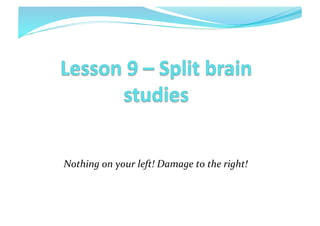
(Lesson 9 2013) split brain studies
- 1. Nothing on your left! Damage to the right!
- 2. From last lesson…. Question 1 Charlotte is diagnosed with Broca’s aphasia. a. Where is Broca’s area located? (1 mark) b. Describe two ways in which her speech could be impaired. (2 marks)
- 3. Charlotte is diagnosed with Broca’s aphasia. a. Where is Broca’s area located? (1 mark) Frontal lobe in the left hemisphere. Both pieces of information were required. Students did not need to state that this is so more than 95 per cent of the time. b. Describe two ways in which her speech could be impaired. (2 marks) Any two of: • produces very little speech • speech requires much concentration and effort • difficulty articulating speech (pronouncing words) • speech tends to be slow and drawn out • short words – prepositions/conjunctions tend to be omitted • sentences tend to be very short (up to four words) • sentences tend to be made up of verbs and nouns only • words lack grammatical endings (for example, –ing). A common error was to list two descriptors of the same difficulty; for example, speech is slurred and poorly articulated; or words are shortened and words lack grammatical endings. Such responses received only one mark.
- 4. This lesson….. Describe split-‐brain studies including the work of Roger Sperry and Michael Gazzaniga Describe spatial neglect caused by stroke or brain injury Explain the contribution of split-‐brain studies to our understanding cognitive processes
- 5. Neglect syndrome Damage to the right parietal lobe Results in the patient completely ignoring the left side of their world, even the left side of their body. Patients eat only the food on the right side of their plate, shave the right side of their face, wash the right side of their body etc. A problem of attention, not blindness!
- 7. What do you mean there’s something wrong with my face?
- 9. Sounds cool until your brain is cut in half
- 10. Corpus Callosum The corpus callosum forms a bridge that connects the left and right hemispheres. The corpus callosum enables communication between the two hemisperes
- 11. Split Brain Surgery Severing the Corpus Callosum Used to treat severe epilepsy Disables communication between the left and right hemispheres
- 13. Information from left visual field is processed in the right hemisphere Information from the right visual field is processed in the left hemisphere
- 14. Split Brain Test Object presented to left visual field (processed in right hemisphere) Cannot name object Can pick correct object up Object presented to right visual field (processed in left hemisphere) Can name object Conclusion – language processing occurs on LEFT
